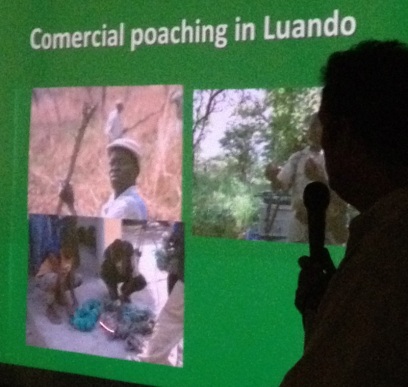Biologist Pedro Vaz Pinto presented an update on Angola’s endangered giant sable (palanca negra gigante) to an audience of over 150 members of the Angola Field Group on October 25, 2012.
In the following video (part one of two) Pedro Vaz Pinto provides an overview of the giant sable including the history and place in Angola’s culture and environment today:
http://www.youtube.com/watch?v=Vqt4vkDLHTk&feature=plcp
In the following video (part two of two) Pedro Vaz Pinto discusses the 2003 launch of the Giant Sable Project and Conservation Initiative in partnership with the Ministry of Environment – the project’s original objective was to locate the giant sable; the creation of the Shepherd Program in 2004; the publication in 2005 of the first photos of giant sable taken since 1982; information about the hybridaztion of the species that has taken place in Cangandala plus more Giant Sable project highlights up to 2008. Since 2009, the bulk of the project’s activities are being implemented by the Kissama Foundation and the main priority now is conservation of the giant sable.
More highlights from the presentation:
2010: The first two calves were born in Cangandala and a new fenced camp of 2400 was created (in the process 10 hybrids were inadvertantedly caught inside).
2011: A new camp of 400 ha was built and a new capture operation was launched; hyrbids were confined in a third camp. The team managed to catch and bring 6 new young females from Luando reserve: three two-year olds and three one-year olds. Two new bulls were also brought in: a young male and one ‘at the prime of life’ named ‘Ivan the Terrible’ due to his uncontrollable nature. Ivan eventually killed the young male and broke through the fence. A third calf was produced.

2012: Two females died of old age; one female became pregnant again and the first calf born in 2010 is now preparing to take over the herd. Currently poaching is the main threat to the giant sable. Snares and pit traps are widely used causing severe trauma and death. A staggering 15% of adult animals captured or photographed had nasty leg injuries caued by traps. About 75% of the Luando reserve is devoid of sables and less than 80 are estimated to survive. The total number of giant sable left is less than one hundred animals making it one of the most critically endangered mammals in the world.


Plan for 2013: Up to twenty giant sable should be darted and released with VHF and GPS tracking devices for monitoring. Infrastructure should be built in Cangandala and the breeding program monitored. Ongoing genetic and ecological research will continue and be reinforced.

To read Pedro Vaz Pinto’s quarterly reports on the Giant Sable Project visit the Giant Sable page on this website.




Leave a comment